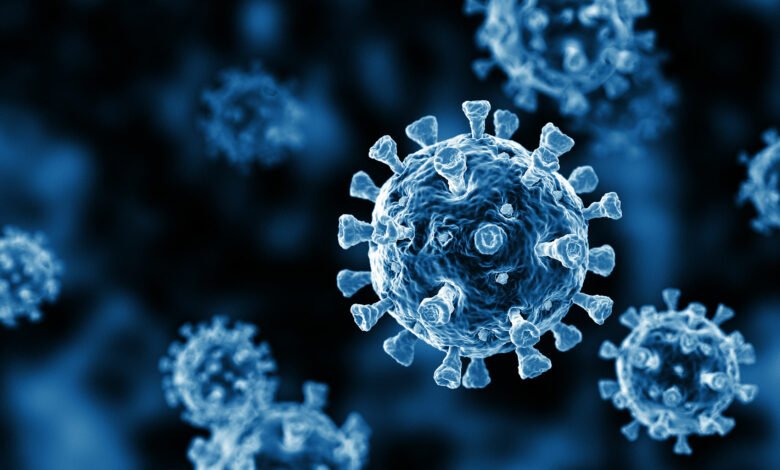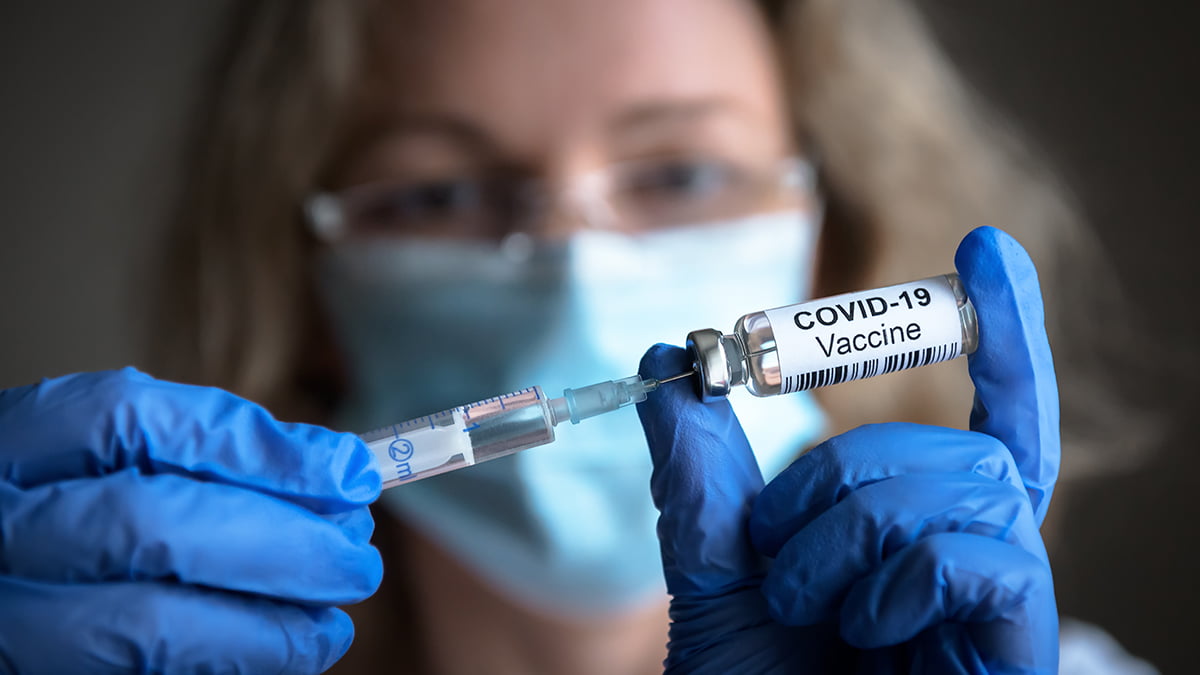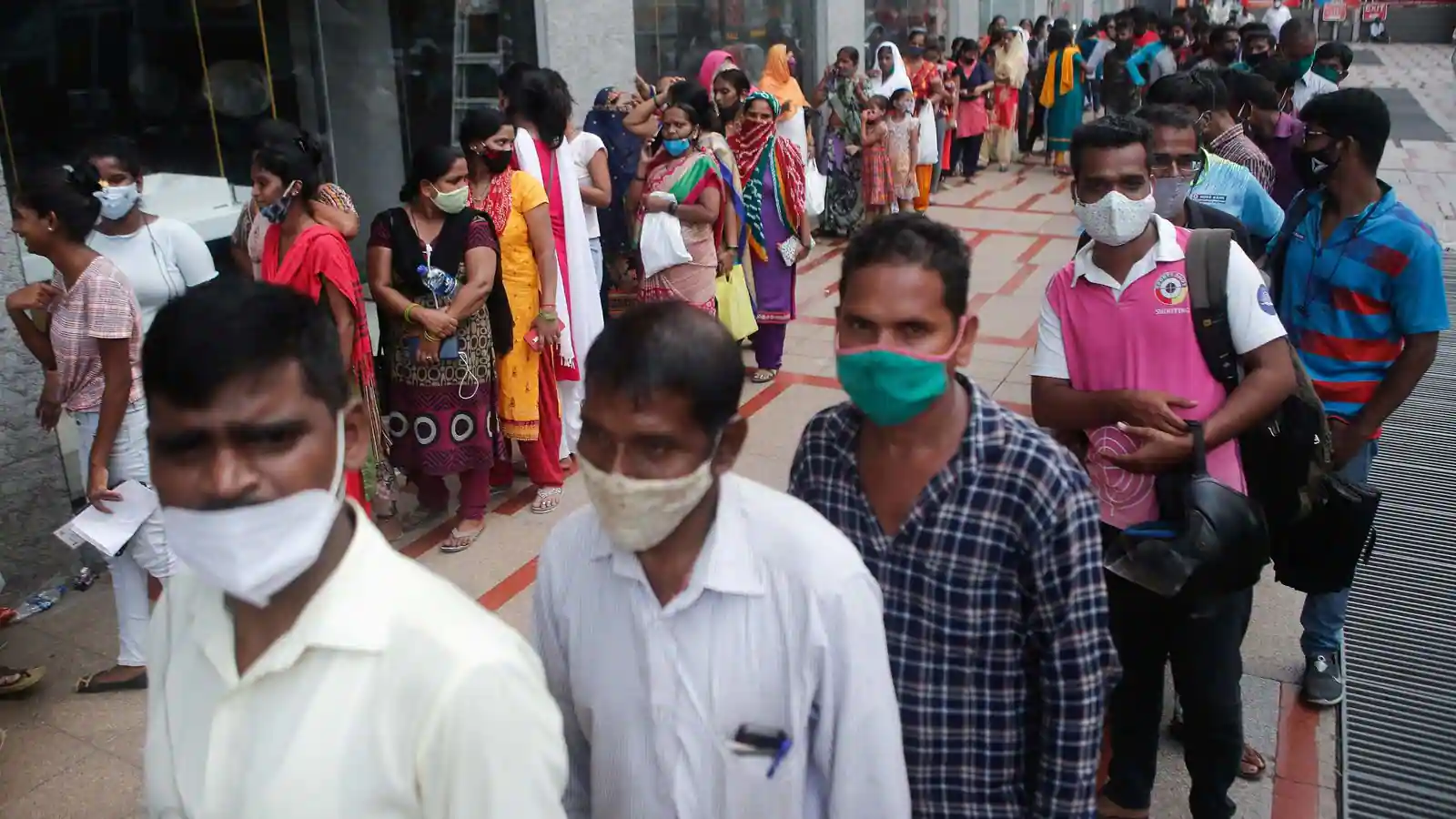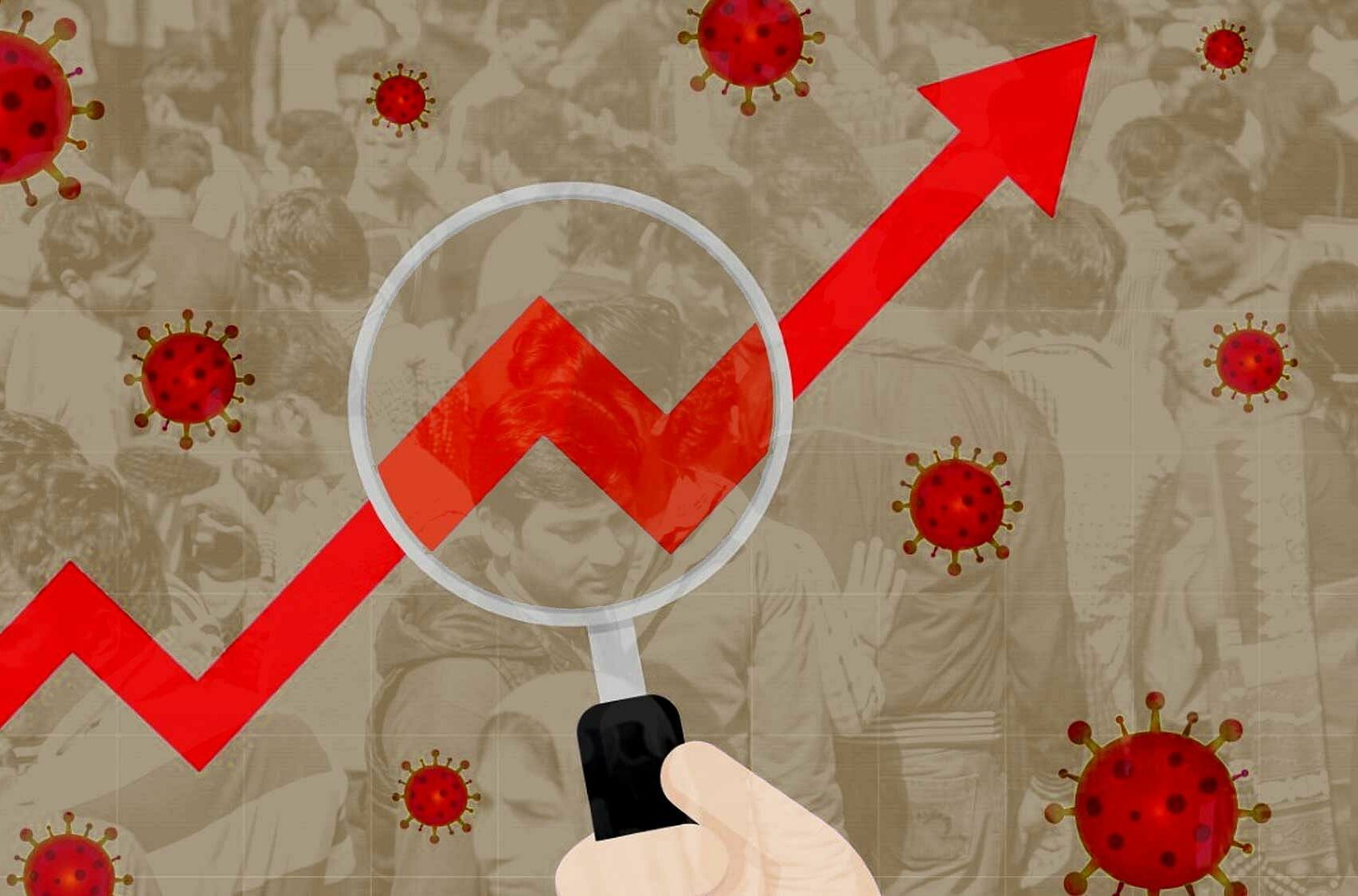COVID-19 tally in India crossed 2-crore mark in May 2021, This Year It Could Reach More than 10-15 Crore Despite Vaccination

COVID-19 tally in India crossed 2-crore mark in May 2021, This Year It Could Reach More than 10-15 Crore Despite Vaccination
India’s cumulative COVID-19 tally topped 2 crores with 3,55,836 new cases until 11.30 p.m. on Monday (May 3), bringing 2,02,75,699. The United States of America is the only other country that has done so. COVID-19 also claimed the lives of 3,434 people throughout the country, bringing the total death toll to 2,22,381.
Updates on Coronaviruses – May 1, 2021
Due to COVID-19, India has surpassed Mexico with the third-highest deaths. The country continued to lead the globe in average daily deaths (3,405), with over 1,000 more deaths than second-placed Brazil. The U.S came in third place with an average of 683 deaths each day. As of Sunday, the country was responsible for one out of every three daily deaths caused by the coronavirus around the world.
Both the tests and the daily vaccination dosages showed a decrease.
On Sunday, little over 15 lakh tests were performed (results were released on Monday), a decrease of over 3 lakh samples from the previous day. It was 1.02 lakh samples greater than the last Sunday’s test (April 25).
The second day in a row, the no. of daily vaccination doses administered throughout the country fell, with only 12.1 lakh shots provided in the 24 hours ending at 7 a.m. on Monday, down over 6 lakh doses from the previous 24 hours.
Vaccination-
India began distributing COVID-19 immunizations on January 16, 2021. India had delivered about 1.52 billion doses as of January 4 2022, including the first and second doses of currently licenced vaccinations. In India, at least one shot has been given to 87 per cent of the eligible population, and 62 per cent of the eligible population has been fully vaccinated.
India was the first country to licence the Oxford–AstraZeneca vaccines (marketed by Serum Institute of India as Covishield) and Covaxin by Oxford–AstraZeneca (a vaccine developed locally by Bharat Biotech). Since then, Sputnik V (production starting in September from Serum Institute of India), Moderna vaccines, Johnson & Johnson vaccine, ZyCoV-D (a vaccine developed locally by Zydus Cadila), and other vaccine candidates undergoing local clinical trials have joined them. The first phase includes initial authorization and the start of the immunization campaign.

First Phase-
India’s former Health Minister, Harsh Vardhan, indicated in September 2020 that the country aimed to approve and provide a vaccine by the first quarter of 2021. Thirty million health staff who deal directly with COVID patients were the first recipients.
The Drug Controller General of India (DCGI) certified the Oxford–AstraZeneca vaccine for emergency use on January 1, 2021. ( local trade name “Covishield”). BBV152 (trade name “Covaxin”), a domestic vaccine produced by Bharat Biotech in collaboration with the Indian Council of Medical Research and the National Institute of Virology, received an interim emergency use authorization DCGI January 2. Because the vaccine had not yet finished phase 3 clinical testing, this approval was received with significant scepticism. Because of this, recipients of Covaxin were asked to sign a consent form, and some states elected to consign Covaxin to a “buffer stock” and focus on Covishield instead.
India began its vaccination programme on January 16, 2021, with 3,006 vaccination centres in operation at the time. Covishield or Covaxin vaccines will be available at each immunization centre, but not both. On the 1st day of availability, 165,714 persons were vaccinated. Due to difficulties uploading beneficiary lists, several sites faced delays. 631,417 persons were vaccinated in the first three days. After 0.18 per cent reported unpleasant symptoms, nine individuals (0.002%) were admitted to hospitals for monitoring and treatment. Due to a combination of vaccination safety concerns, technical challenges with the software used, and disinformation, there were concerns about poor turnout in the early days.
In the first implementation phase, health staff and frontline employees such as police, paramilitary forces, sanitation workers, and disaster management volunteers were involved. As of March 1, just 14 million healthcare and frontline workers have been vaccinated, falling short of the 30 million targets.
Second phase
The vaccination deployment’s second phase comprised those over the age of 60, residents between 45 and 60 with one or more qualifying comorbidities, and any health care or frontline worker who did not receive a dose during phase 1. Online registration for the Aarogya Setu app and the Co-WIN (“Winning over COVID-19”) website began on March 1.
Vaccine exports were halted in March 2021, as the country started to see a large second wave of infections, and the government purchased 110 million Covishield doses from SII. The company expects to produce 100 million tablets per month, but its capacity in May 2021 was only 60–70 million. Following its trial, the DCGI granted Covaxin a regular emergency use licence on March 11, 2021.
Since April 1, all residents over 45 have become eligible. On April 8, Prime Minister Narendra Modi declared a four-day Teeka Utsav (“Vaccine Festival”) from April 11 to 14 to expedite the immunization programme by vaccinating as many eligible residents as possible. By the end of the festival (India had surpassed 111 million vaccine doses.

Third phase, Sputnik V approval
On April 12, the DCGI approved Russia’s Sputnik V vaccine for emergency use in India. The phase 3 trial was conducted in the country in September 2020, with 91.6 per cent success. The vaccine’s local distributor, Dr Reddy’s Laboratories, stated that the vaccine would be ready in India by late May 2021.
According to an announcement issued on April 19, the second phase of the immunization campaign will begin on May 1 and be open to all citizens over 18. During phase 3, individual stakeholders were also given additional leeway in carrying out the immunization programme.
Under this plan, the federal government would distribute only half of the vaccinations procured from manufacturers by the Central Drugs Laboratory. This supply would be delivered to government-run clinics and made available free of charge to people 45 and older and priority employees, with money awarded to states depending on factors like the number of active cases and the speed with which vaccines are administered. The rest would be sold on the open market to individual states (including private hospitals) and allowed to serve patients above 18.
The next round of registration began on April 28, with a single-day record of approximately 13.3 million people registering. Many states, including Delhi, Gujarat, and Madhya Pradesh, have declared that their vaccine rollouts will be delayed until later this month due to supply concerns.
The first cargo of 150,000 Sputnik V dosages arrived on May 1, and the first doses were given out on May 14. An estimated 156 million doses are expected; initially, doses will be imported from Russia, but domestic production will start in August 2021.
Covaxin phase 2 and phase 3 trials on children aged 2 to 18 were approved by the DCGI on May 13. On May 14, health officials predicted that between August and December 2021, it might get at least 2.17 billion more vaccine doses, depending on the expected approval of additional vaccination choices. On May 25, India has provided over 200 million vaccination doses in total. 300 million doses of Corbevax were pre-ordered by the Ministry of Health and Family Welfare., a possible fourth vaccine currently in phase 3 clinical testing, on June 3.
The union administration authorized walk-in vaccination registrations across the country on May 23, with a health worker at the vaccination centre registering the recipient in the Co-win vaccination database. In an affidavit to the Supreme Court, the administration claimed that as of June 23, around 78 per cent of immunizations had been delivered via walk-in registration.

Return to centralized procurement
On May 31, an affidavit was filed in India’s Supreme Court, asking a review of the central government’s vaccine distribution plan, claiming that the choice to exclusively distribute free vaccination shots to priority workers and residents over 45 was “prima facie arbitrary and unreasonable.”
Prime Minister Modi declared on June 7 that India would return to centralized vaccine procurement by June 21. Modi claimed in an address that some chief ministers had asked the federal government to reconsider its new distribution strategy and return to the structure in place before May.
As before, the centre will buy up to 75% of the country’s vaccination supply in bulk from producers and distribute them to states at no cost. Vaccines would now be provided free of charge to adults aged 18 to 44. Private hospitals will continue to be in the order of the remaining 25% of procurement, but appointment costs have been set at $150 (US$2.00).
On the day these adjustments went into effect, roughly 8,270,000 doses were given out, making it India’s greatest single-day total to that moment. Madhya Pradesh and Karnataka were the states with the highest local totals. P. Chidambaram, a member of the Rajya Sabha, accused the Bharatiya Janata Party of “hoarding” vaccine doses in the days leading up to June 21 to encourage more significant numbers; seven BJP-controlled states were among the top ten states to administer vaccine doses on that day, and a few of these states had below-average vaccination numbers in the days leading up to June 21.
India reached a milestone of over 300 million vaccination doses delivered on June 23. India surpassed the United States in total vaccine doses administered on June 28. The DCGI approved the Moderna vaccine (which Cipla imports) for emergency use on June 29. According to Vinod Kumar Paul, the Pfizer vaccine is also expected to be authorized soon.
The approval of Johnson & Johnson’s Covid-19 vaccine, which has a market value of $500 million, has set a new milestone.
On August 6, 2021, India passed the 500 million doses mark, just six months after the immunization campaign.
On August 7, 2021, the Drug Controller General of India (DCGI) approved Johnson & Johnson’s single-dose vaccine for emergency use. India gave around 8.81 million doses of COVID-19 vaccines on August 16, 2021, beating the previous single-day record of 8.61 million doses. By August 16, the total number of dosages had surpassed 55 million. For ages 12 and up, ZyCoV-D approval is required, as well as single-day immunization records.
India awarded an emergency use licence to ZyCoV-D, the world’s first DNA-based COVID-19 vaccine, made by Zydus Cadila, for adults and children aged 12 and up on August 20, 2021. A needle-free applicator is used to give the vaccine. On September 30, 2021, the government announced that the ZyCoV-D vaccine would be a three-dose vaccine included in India’s Covid vaccination programme.
Foreign nationals residing in India have been able to receive the COVID-19 vaccine by registering on the Cowin platform since August 10, 2021. Like other eligible beneficiaries, foreign nationals can book a slot through the portal and use their passport to verify their identity during the registration process.
By August 26, 2021, half of India’s adult population has received at least one dose of recommended vaccines, with 99 per cent coverage among healthcare workers and 100 per cent coverage among front-line workers for the first dosage.
India achieved a new global record on August 27, 2021, when it administered more than 10 million (1 crore) doses of COVID-19 vaccination in a single day. With 2.8 million doses, Uttar Pradesh was first, followed by Karnataka with 1 million doses, and Maharashtra in third place with 0.98 million doses.
Himachal Pradesh became the first state to finish administering the first doses of COVID-19 vaccines to 100% of the population on August 29, 2021. India achieved a new single-day vaccination record on August 31, inoculating nearly 12 million (1.2 crores) doses in under 24 hours.
By September 2021, every adult in Sikkim, Dadra and Nagar Haveli, Himachal Pradesh, Goa, Ladakh, and Lakshadweep had gotten at least one dose of Covid vaccine, with the total number of vaccines provided in the country has surpassed 75 crores. Many municipal corporations, talukas, gramme panchayats, and districts had also given the first dose of COVID-19 vaccine to their whole adult population.
On November 17, 2021, 25 million individuals were vaccinated on Narendra Modi’s birthday. This is the world’s biggest single-day immunization total to date. There are suspicions that staff were under duress to boost and twist vaccination counts on the Prime Minister’s birthday since some persons who had not had their Covid shots, including those who were deceased, were somehow handed immunization certificates.
On September 27, India administered over one crore vaccine doses for the seventh time, bringing total immunization coverage to 86 crore people (860 million).
Mansukh Mandaviya, the Union Health Minister, declared on October 2 that India had reached a milestone of 90 crore vaccination doses administered.
The one-billion-dollar mark, a vaccine clinical trial for children aged 7 to 11, and the government’s position on booster injections.
On September 28, 2021, the government and India’s medicines regulator permitted vaccine maker Serum Institute to enrol children aged seven to eleven in its COVID-19 vaccine study.
The subject of COVID-19 vaccine booster doses gained traction after people in many Western countries were inoculated with the booster dosage or the third dose. The issue is raging in India, where the Covid vaccination effort began in January, and a large portion of the eligible population has already received at least one shot. Although the Indian government has insisted that booster shots of Covid vaccinations and the benefits they bring are under investigation, the current focus should be on ensuring that every adult in the country receives two doses.
India reached a milestone of one billion doses delivered on October 21, 2021.
According to Prime Minister Narendra Modi, booster dose and vaccination for children in India will begin administering booster injections to health and frontline workers and individuals over 60 with comorbidities or other health concerns from January 10, 2022. He also stated that immunizations for youngsters aged 15 to 18 would commence on January 3, 2022.
Prioritization and sequencing for healthcare and frontline workers and individuals aged 60 and older with comorbidities would be based on completing nine months or 39 weeks from the second dose as of January 10, according to the government’s instructions. Children aged 15 to 18 can register online on CoWin beginning January 1, 2022, or in person at immunization centres starting January 3, 2022. The only covid vaccination available for children aged 15 to 18 is Covaxin.
Then why are Covid-19 instances on the rise despite record vaccination rates?
Here’s why Covid is spreading across the country once more. Most states and large cities have observed increased cases, which was not noticed last year during the Dussehra and Diwali festival seasons. On December 31, India recorded 16,764 new Covid cases, up 27% from the previous day. After more than two months, the figure surpassed 16,000 people—the state with the most Omicron cases in Maharashtra. On December 31, the state saw a massive increase in daily instances, with 5,368 cases reported, bringing the total number of Omicron infections to 450.
On December 30, 1,313 people tested positive for Covid-19 in Delhi, the highest single-day total in seven months. There are presently 320 Omicron cases in the system. The state authorities declared that Omicron had commenced local transmission after the positive rate soared to 1.73 per cent. Omicron cases were discovered even among people who had never travelled.
Punjab and Bihar have also seen considerable increases in new cases reported daily. The national positive rate is 1.87 percent, which is still below the WHO (World Health Organization) recommendation of 5%. Still, experts warn that any complacency now would lead to calamity since unrestrained Covid distribution causes very rapid increases. “Once the positive rises above 5%, controlling the spread becomes more difficult, and more restricted measures must be taken,” says Dr Randeep Guleria, director of AIIMS in New Delhi.
Even though India is on the verge of a third wave, public crowding persists. Throughout last week, key markets in Delhi, such as Sarojini Nagar, Lajpat Nagar, and Chawri Bazaar, were crowded. On December 29, almost 4,300 violations of Covid safety guidelines were reported from Delhi, with 97 per cent of the violations including the inappropriate use of masks or the failure to wear them at all. “Against all Covid forms, the mask is the primary defence.
“A vaccine may assist in limiting the infection to a mild form, but only a decent mask worn properly may stop the virus from spreading,” says Dr Ankita Baidya, an infectious diseases specialist in Delhi.
Masks are still being used without adequately covering the nose and mouth, and cotton masks are being utilized, which cannot block the virus. “The viral particle is tiny,” says the researcher. Cloth isn’t going to cut it. Furthermore, because your face must be airtight, an ill-fitting mask is ineffective,” explains Jai Dhar, creator of Nirvana Being, a Covid mask manufacturer.
Experts agree that the simplest and most fundamental measure in preventing the third wave in India is to achieve complete mask coverage. The fault does not lie with the new Covid variation but rather a lack of public understanding of Covid regulations.
As the number of Covid-19 patients rises, it appears that both unprotected and vaccinated people are being admitted to hospitals in equal numbers. Several hospitals in the National Capital Region are experiencing many new patients, most of whom have taken both shots against Covid-19.
According to experts and researchers, Omicron appears to multiply far more quickly than earlier varieties. Infected people with high virus loads are more likely to transmit it to others, mainly the unvaccinated.
When those who have been vaccinated get the virus, they are more likely to experience minimal symptoms, if any, since the vaccines activate various immune defences, making it more difficult for Omicron to get through.
According to evidence from the United States and the United Kingdom, people who received two doses of Pfizer or Modern vaccinations experienced a considerable decline in effectiveness, albeit the vaccines did demonstrate some immunogenic response against Omicron.
Edited and proofread by Ashlyn




